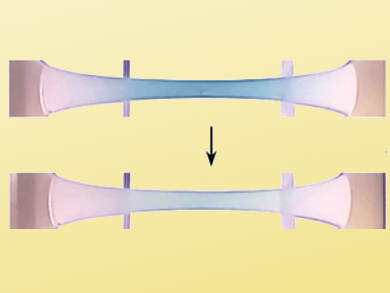Michael Sommer, University of Freiburg, Germany, and colleagues have developed a sensor material that converts mechanical stress into color. While this effect, known as mechanochromism, is well-known and has been demonstrated for various polymeric systems, most mechanochromic polymers rely on irreversible reactions or require additional stimuli to drive the back reaction and allow repeated switching.
The team achieved a reversible effect by designing a copolymer that comprises phenyl rings as a tough backbone and a spiropyran unit as a mechanochromic dye or force sensor. The phenyl rings stabilize the colorless form of the spiropyran and destabilize the compound’s colored merocyanine form. Thus, the colored form becomes stable only under the application of large forces, which the tough polyarylene can withstand.
The mechanochromic response of the synthesized polymer is fast: after the force is released from the colored material, the color vanishes without delay, thus allowing repeated use. The possibility to directly visualize the build-up and release of forces in synthetic polymers at the molecular level has important implications for materials science.
- A Simply Synthesized, Tough Polyarylene with Transient Mechanochromic Response,
Fabian Kempe, Oliver Brügner, Hannah Buchheit, Sarah N. Momm, Felix Riehle, Sophie Hameury, Michael Walter, Michael Sommer,
Angew. Chem. Int. Ed. 2017.
https://doi.org/10.1002/anie.201709142

![Synthesis of [c2]Daisy Chains via Mechanochemistry](https://www.chemistryviews.org/wp-content/uploads/2025/04/202504_RotaxanesWithSolidStateMechanochemistry-125x94.png)

